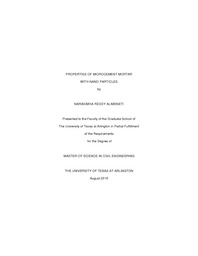
ATTENTION: The works hosted here are being migrated to a new repository that will consolidate resources, improve discoverability, and better show UTA's research impact on the global community. We will update authors as the migration progresses. Please see MavMatrix for more information.
Show simple item record
| dc.contributor.author | Alimeneti, Narasimha Reddy | en_US |
| dc.date.accessioned | 2015-12-11T23:20:12Z | |
| dc.date.available | 2015-12-11T23:20:12Z | |
| dc.date.submitted | January 2015 | en_US |
| dc.identifier.other | DISS-13345 | en_US |
| dc.identifier.uri | http://hdl.handle.net/10106/25403 | |
| dc.description.abstract | Carbon nanotubes (CNT) and Carbon nanofibers (CNF) are one of the toughest and stiffest materials in the world presently with extreme properties yet to be discovered in terms of elastic modulus and tensile strength. Due to the advanced properties of these materials they are being used in almost all fields of science at nanolevel and are being used in construction industry recently for improvement of material properties. Microcement is fine ground cement which as half the particle size of ordinary Portland cement. In this research the behavior of cement mortar of micro cement with the addition of nanoparticles is studied.Due to high aspect ratio and strong van der Waal forces between the particles of CNT and CNF, they agglomerate and form bundles when mixed with water, sonication method is used to mix nanoparticles with few drops of surfactant and super plasticizer. Mechanical properties such as compressive strength and flexural strength with CNT and CNF composites are examined and compared with control samples. 0.1% and 0.05 % of nanoparticles (both CNT and CNF) by the weight of cement are used in this research and 0.8% of super plasticizer by weight of cement was also used along with 0.4, 0.45 and 0.50 water cement ratios for making specimens for compression test. The compressive strength results are not satisfactory as there was no constant increase in strength with all the composites, however strength of few nanocomposites increased by a good percentage. 0.5 water cement ratio cement mortar had compressive strength of 7.15 ksi (49.3 MPa), whereas sample with 0.1% CNT showed 8.38 ksi (57.8 MPa) with 17% increase in strength after 28 days. Same trend was followed by 0.4 water cement ratio as the compressive strength of control sample was 8.89 ksi (61.3 MPa), with 0.05% of CNT strength increased to 10.90 ksi (75.2 MPa) with 23% increase in strength. 0.4 water cement ratio was used for flexural tests including 0.1%, 0.05% of CNT and 0.1%, 0.05% of CNF with 0.008 ratio of super plasticizer. Results showed that there was a significant increase in strength initially but gradually decreased as the time increase and showed decreased strength at 28 days when compared to control samples. Flow cone results are quite satisfying as the flow is significantly increased with the addition of nanoparticles. Time of efflux of control sample is 16.22 sec whereas for specimen with CNT had a time of efflux 12.67 sec and sample with CNF showed 13.65 seconds. Setting time test was carried on 0.4 water cement ratio. Composites with nanoparticles exhibited faster setting when compared to its control sample. Bleeding was not observed with the nanoparticles in the cement mortar. Shrinkage test was conducted on sample with 0.4 water cement ratio with 0.05% of CNT and CNF. Shrinkage was very small in the samples with nanoparticles. | en_US |
| dc.description.sponsorship | Yazdani, Nur | en_US |
| dc.language.iso | en | en_US |
| dc.publisher | Civil & Environmental Engineering | en_US |
| dc.title | Properties Of Microcement Mortar With Nano Particles | en_US |
| dc.type | M.S. | en_US |
| dc.contributor.committeeChair | Yazdani, Nur | en_US |
| dc.degree.department | Civil & Environmental Engineering | en_US |
| dc.degree.discipline | Civil & Environmental Engineering | en_US |
| dc.degree.grantor | University of Texas at Arlington | en_US |
| dc.degree.level | masters | en_US |
| dc.degree.name | M.S. | en_US |
Files in this item
- Name:
- ALIMENETI_uta_2502M_13345.pdf
- Size:
- 1.994Mb
- Format:
- PDF
This item appears in the following Collection(s)
Show simple item record


